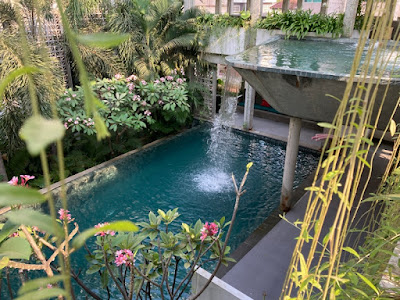Part of a series: Asia, March 2023:
- Taiwan—Taipei American School
- Malaysia—EARCOS conference (Kota Kinabalu)
- Malaysia—Survivor Island (Borneo)
- Cambodia—schools and history in Phnom Penh
- Cambodia—Siem Reap
- Cambodia—Angkor Wat/other temples
On 3/26/23, after a dream day on Survivor Island (Pulau Tiga off the coast of Borneo), I woke at 2:50 am for my 3:20 am ride to the airport for my 5:20 am flight to Phnom Penh. This would be my third week in Asia and my third country on the trip.
rotary design, Phnom Penh style
That it was, in more ways than one.
When I was there, the lows were in the high 70s, highs in the mid-90s.
My Phnom Penh hotel, Baitong, was a form of a dream as well—no false notes. Wonderful staff, nicely designed, environmentally conscious, good food, the convenience of good food on site, cool rooftop for eating that food, a small bakery on site with nutless banana muffins (my favorite), even a tranquil “forest pool.”
It also had a second, more traditional pool...except for the fact that you could look up into the pool from the lobby.
Soon after settling in, I set out for what would be the two most emotionally challenging stops of my three weeks in Asia: the Tuol Sleng Genocide Museum (formerly the S-21 torture prison, and before that, a high school) and the Killing Fields.
I went in knowing virtually nothing about Pol Pot and the Khmer Rouge, the Communist regime that tyrannized its own people from 1975 to 1979. For starters, I did know not “Khmer” is a term that some Cambodians use to refer to themselves and their language. And while I was familiar with the term “Killing Fields” (from the title of a movie I’ve never seen), I did not know that it refers to more than one site around the country, though it now seems obvious.
The prison was converted to a museum very quickly after the Vietnamese toppled Pol Pot’s rule. The place is almost unbearable. You walk throughout rooms where innocent people were tortured beyond human comprehension. In some spots you think you can almost still see the bloodstains on the floors and walls. At least 20,000 Cambodians suffered and were murdered there. The number known to have survived: 12.
a victim. It was grotesque and profoundly sad.
I visited the most well-known Killing Fields site, Choeung Ek, which is in Phnom Penh. Also nearly unbearable.
For the next three days, I spoke at two schools: Canadian International on Monday and Tuesday, Australian International on Wednesday. Yes, an American speaking at a Canadian and an Australian school in Cambodia. That’s some kind of punchline in the making. Yet for now, it was only a fulfilling round of assemblies and writing workshops with a largely Cambodian group of young people.
Though I’ve been to Asia multiple times before, including a similarly long trip in 2016 (that also included three countries, one of which was also Malaysia), this trip marked the first time I rode in a tuk-tuk (three-wheeled, motorized taxi common throughout Asia). It was how I got to and from CIS. With an app called Grab (comparable to Lyft), it was easy—and not nearly as loud or fast as I was expecting. The breeze was nice, too.
Thank you again to my hosts at both schools, Lisa and Stacy, for the enriching privilege of visiting your country. They took a chance on me on fairly short notice and I’m grateful. I was Stacy’s first in-person author since COVID, her first American author…and since she’s retiring at the end of the school year, her last author.
.jpg)
.jpg)
.jpg)
.jpg)
.jpg)
.jpg)
.jpg)
.jpg)
.jpg)
.jpg)
.jpg)
.jpg)
.jpg)
.jpg)
.jpg)
.jpg)
.jpg)
.jpg)
.jpg)
.jpg)
.jpg)
.jpg)
.jpg)
.jpg)
.jpg)
.jpg)
.jpg)
.jpg)
.jpg)
.jpg)
.jpg)
.jpg)
.jpg)
.jpg)
No comments:
Post a Comment